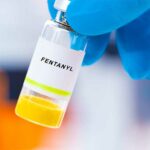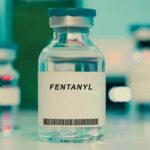Fentanyl is a synthetic opioid used to treat severe pain. It’s used very sparingly as it’s far more potent than other opioids like morphine, oxycodone, and heroin.
The drug is also considered a schedule II controlled substance by the FDA and DEA. This means it has a high potential for abuse and can be very addictive.
What fentanyl looks like depends on the form it’s in, if it’s been mixed with another drug, or if it’s been tampered with.
What Does Fentanyl Look Like?
What fentanyl looks like depends on the type of fentanyl, which can vary depending on what it’s used for. The main types include the patch, liquid, tablets, nasal spray, and powder.
Fentanyl Patch
Prescription fentanyl can come in patches that you place on the skin. They are completely clear and include the name and dosage of the drug right on the patch.
There are also specific brands of fentanyl patches like Duragesic. If your patch is Duragesic, it will say so on the patch.
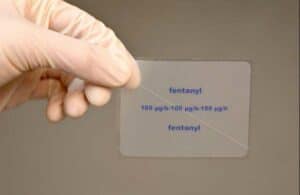
Fentanyl Liquid
This form of fentanyl comes in a clear vial and has the information listed on the outside. This type of fentanyl is usually injected.
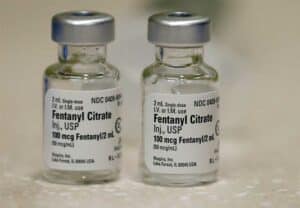
Fentanyl Tablets
Prescription fentanyl tablets can be found under the brand names Fentora and Abstral. The tablets are white and have a “C” on one side and a number (2, 4, 6, or 8) on the other.
Unfortunately, drug dealers are very good at making pills that look like prescription fentanyl but are actually counterfeit pills. They are often blue in color but can be pink, orange, and even green.
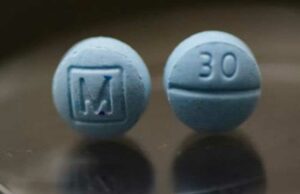
Fentanyl Lollipops
The pain medication can also come in a lozenge that is referred to as a fentanyl “lollipop.” The lozenge is attached to a stick or a handle. The lozenge is red while the stick is white. The end of the stick has the name of the drug on it along with the dosage.
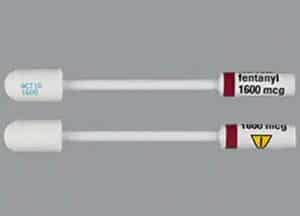
Fentanyl Spray
Fentanyl can also come in a nasal spray. In this form, you can find it under the brand names Subsys, PecFent, and Lazanda. When sprayed, the liquid is clear.
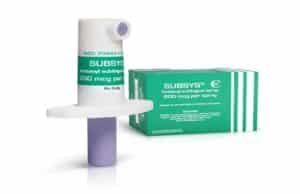
Fentanyl Powder
Fentanyl can also come in a powder form that’s often mixed with other drugs.
When cocaine or methamphetamine is cut with fentanyl, the mixture may have brown patches or be off-white. But looking for this color difference isn’t a foolproof way to spot fentanyl.
The best way to ensure you’re not unknowingly ingesting fentanyl is to stay away from illicit drugs altogether. Your health will likely benefit and you’ll lower your risk of overdose.
If that’s not an option, there are fentanyl test strips you can use to test if a drug is cut with fentanyl.
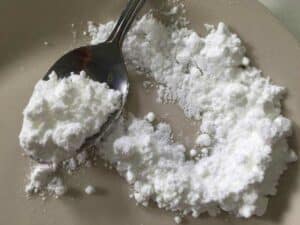
Purple Fentanyl/Heroin
There is a relatively new substance called “purple heroin” but it’s not heroin at all. It can contain many different things including fentanyl, niacinamide, acetaminophen, buspirone, and morphine. It’s also dyed purple, which is where it gets its name from.
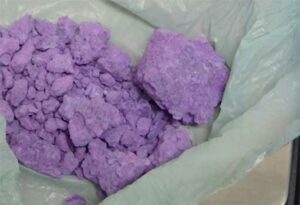
Side Effects Of Fentanyl
No matter what the fentanyl you’re using looks like, it will likely come with a number of different side effects. Some may be mild while others could be more severe.
The most common side effects include:
- sedation
- confusion
- drowsiness
- dizziness
- nausea/vomiting
- urinary retention
- constricted pupils
- respiratory depression
- constipation
- unconsciousness
Fentanyl Overdose
According to the Centers for Disease Control and Prevention (CDC), fentanyl is one of the most common drugs involved in opioid overdose deaths.
Because the risk is so great, it’s not only important to know what fentanyl looks like, it’s also important to know the signs of a fentanyl overdose:
- constricted pupils
- falling asleep
- losing consciousness
- slow breathing
- clammy skin
- discolored skin
If you experience any of these side effects, seek medical attention from a healthcare provider immediately.
Treatment For Fentanyl Addiction
There are several forms of treatment for those with fentanyl addiction. One of the most common treatments is medication-assisted treatment (MAT).
MAT involves a healthcare provider prescribing medication like buprenorphine and methadone. They both help reduce cravings and withdrawal symptoms.
Naloxone is another medication that prevents fentanyl from taking effect. This can be particularly effective in case of a fentanyl overdose.
If you or a loved one is struggling with fentanyl abuse, please contact Northeast Addiction Treatment Center today.
Sources
Written by
Northeast Addition Editorial Team
©2024 Northeast Addition Center | All Rights Reserved
This page does not provide medical advice.


